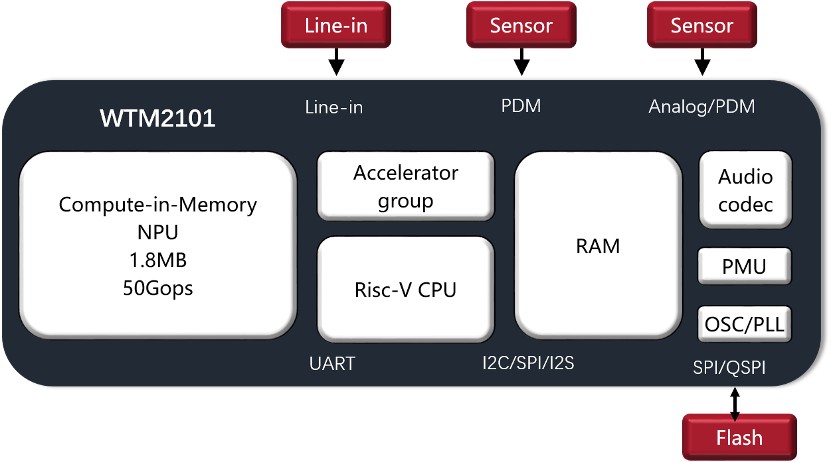Witmem Technology releases WTM computing in memory chip to help achieve AI+ high computing power with ultra-low power consumption in smart wearables.
As consumers increasingly demand diversified and intelligent functions from smart wearable devices, the smart wearable industry needs to invest more in research and development and production costs to achieve product feature stacking or performance improvement. Constrained by the small form factor and cost control, the demand for high computing power and low power consumption, as well as the contradiction with the traditional von Neumann architecture, has become increasingly prominent. In this context, with the mass production of the world's first computing in-memory SoC chip WTM2101 in 2022, many manufacturers have begun to seek a breakthrough in this new type of computing architecture and have successfully developed and launched products, entering the lives of consumers.
1.Chip model: WTM2101
2.Chip type: ultra-low power AI SoC chip
3.Application: intelligent voice and intelligent health
4.Package: WLCSP (2.6x3.2mm²)
5.Power consumption: 5uA-3mA
6.AI computing power: 50Gops
7.Maximum model parameters: 1.8M
Feature 1: Based on computing in-memory technology, it achieves high computing power and low power consumption The principle of computing in-memory technology is based on Ohm's law, which improves the efficiency of matrix multiplication by 50-100 times. The WTM2101 has both ultra-low power consumption and high computing power. Compared to NPU, DSP, and MCU computing platforms, the WTM2101's AI computing power has been increased by 10-200 times, with power consumption ranging from only 5uA to 3mA. In particular, for computing power above one gigaflop, the WTM2101 chip based on computing in-memory technology can better leverage its advantages in scenarios such as TWS earphones, walkie-talkies, hearing aids, and other applications that require human voice enhancement, noise reduction, and NN anti-howling algorithms.
Feature 2: Under typical application scenarios, it has both versatility and ease of use The WTM2101 chip is a versatile SoC that is easy to develop. It includes a 1.8M computing in-memory NPU, CPU, accelerator group, RAM, and even traditional classical algorithms can run smoothly. At the same time, the WTM2101 chip also has many low-power interface designs, which can realize the extraction and real-time processing of multiple sensors, and also support direct input and processing of audio signals.
For TWS and wearable devices, the WTM2101 provides an ultra-small WLCSP package of 2.6x3.2mm², which can use any one or several of the I2C/I2S/SPI/UART interfaces for data communication and control. For audio input, the WTM2101 also provides analog and PDM encoding and decoding, as well as bypass output, making it easy for system integration and expanding audio channels. Meanwhile, Witmem Technology has developed and provided rich software tools that can help more developers develop mature solutions based on the WTM2101. These advantages make the WTM2101 better able to meet the demands of the smart wearable product market and are easy to use.
WTM2101 Chip Framework

Example of application advantages: AI noise reduction algorithm
Traditional noise reduction algorithms, when achieving directional sound pickup through phase, can cause certain damage to human voice, resulting in muffled sound; they cannot effectively reduce noise from the same direction as the human voice source; and they cannot have a significant effect in high noise environments such as subways, high-speed trains, cafes, and roads. With the high computational power advantage of the WTM2101 chip, customers can directly analyze collected audio and use deep learning to separate human voice from noise, generating clean human voice, and achieving real-time computation with a delay of less than 8ms. This reflects the WTM2101 chip's strong technological advantages in low power consumption, low latency, and high computational power.
Example of application advantages: Command word recognition
The WTM2101 chip supports command word recognition algorithms, supporting continuous recognition of up to 300 words, and word replacement does not require retraining the algorithm. It can also support wake-up-free recognition. In customer applications, the WTM2101 chip can achieve a power consumption of less than 1mA for data processing and recognition, including the microphone. In addition, in different countries or regions where multiple languages are used, the WTM2101 can leverage its chip advantages without the need to replace the algorithm.
Example of application advantages: Health monitoring
In customer applications in the health field, the WTM2101 chip can achieve real-time processing of PPG, ECG sensors with ultra-low power consumption, enabling health monitoring applications, including monitoring blood pressure, blood sugar, blood oxygen, identifying movements, and recognizing wrist gestures, and more. Compared with the lowest power consumption data of other chips on the market, the WTM2101 can achieve a power consumption reduction of about 6-10 times, greatly improving standby time, especially for wearable products, and commonly used products in health scenarios.
评论
发表评论